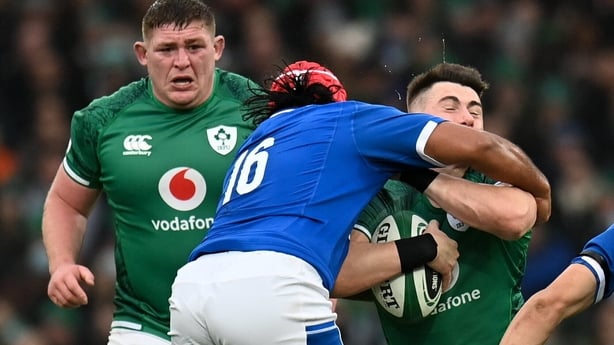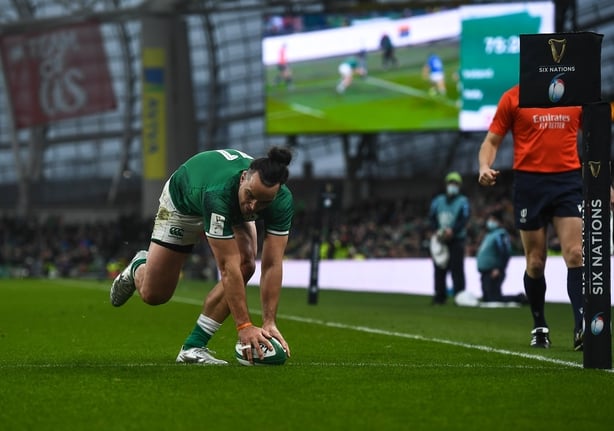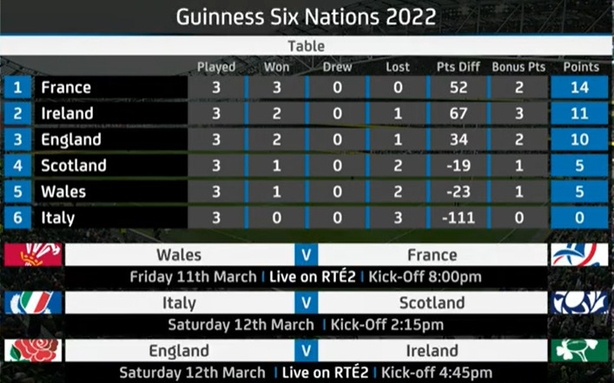It was an unfortunate sequence of events that reduced the Ireland versus Italy game to a foregone conclusion on Sunday at the Aviva Stadium.
Calls for a change in the laws are justified because nobody should lose two players for one sending-off incident.
Especially when Gianmarco Lucchesi, Italy's starting hooker, was genuinely injured.
However, don’t tell me that Hame Faiva didn’t deserve the red card for his high hit on Dan Sheehan.
You can get frustrated with the laws and how one moment in a tackle potentially destroyed the game, but don’t say that Faiva didn’t intentionally opt for a higher tackle focus.
Sheehan stands at around 6' 3" and was high enough going into the tackle for Faiva make contact with at least 4 feet of him legally.
You also can’t say convincingly that Sheehan dipped into that contact.
He is well within his rights to run at that height into the tackle area without getting a shoulder to the chin or neck area. It was a red card and referee Nika Amashukeli had a very consistent game.

What played out afterwards was of little benefit to anybody.
Ireland would have preferred to play against Italy’s 14 players instead of having them reduced to 13.
I’d say if given the choice, Ireland would have reinstated the Italian team to 15 players so they could get a real test under their belts before taking England on in Twickenham in two weeks.
Uncontested scrums didn’t benefit the Irish front row.
Finlay Bealham and David Kilcoyne came on for Ireland but didn’t get to put their hand up in the most important aspect of their game.
Props need to scrummage and need to get live scrums at international level. Training reps and club games won’t prepare them for the cauldron of international scrummaging.
Likewise, Ireland won’t have learned much from their set-piece attack, other than the frustration of forcing the issue and attempting to score off the first phase numerous times.
They fell into the trap of thinking that there was easy space to manipulate in the back line and that they should be able to beat it with a killer pass.
Ireland pushed James Lowe into touch from a set piece play when attacking against five Italian backs, Mack Hansen kicked a number of balls down the touchline in the hope of exploiting space in the back field and it felt as if Ireland weren’t willing to string phases together to get their scores.
It’s an easy trap to fall into.
Italy had to up their game and cover the players that they didn’t have in the back line.
They had to rush up off their defensive line even harder than they usually do, which would leave space in the back field but kicking the ball is always dependent on how the rugby ball bounces.
Ireland gained territory from these kicks but never really strung the phases together.

Irish backs didn’t run at inside shoulders as accurately as they would do against a full Italian back line because there was also space on the edges.
Getting caught in two minds like that and not running with the same conviction allowed Italy to push Ireland to the side.
Italy also turned Ireland over at a number of breakdowns despite being two men light in defence. I’m sure that will frustrate Andy Farrell and the other coaches when they look back at their efficiency throughout the game.
However, Ireland got out of there with nine tries, game time for some of their squad players, a successful debut for Mike Lowry and almost a clean bill of health.
They were never going to get much credit for winning the Italy game anyway.
Robbie Henshaw will be a worry, having to undergo a HIA late on in the game and Andrew Porter limped off with a slight ankle issue but other than that Ireland have a good bill of health going into two huge rounds of rugby after a week off this weekend.
I don’t think players will over analyse what they did against Italy.
Likewise, I don’t think England will be looking too closely at it either.
Most of what they will see on the video will be false. False space on the pitch and false decision-making by the Irish players. Ireland would have chosen different set pieces or different starter plays had they been playing against 15 players.
Even when you look at the decision-making of teams in the final quarter of a game when they’re winning well, they won’t be making the same decisions as if the game was in the melting pot.
Farrell touched on the fact that Ireland kept going to their second line of attack, which essentially means you’re trying to get the ball wide. When they went back to using the front-door harder carries, they built phases and were able to score.
England shouldn’t expect Ireland to go wide-wide from set piece, or to kick the ball down the touch line, or to be turned over after one phase of attack so often.
It was uncharacteristic of the team, and we hadn’t seen that lack of accuracy against much stronger opposition in this tournament so far.
It’s hard to make the right decision in attack when the defence is so erratic.
The game also didn’t have the same level of consequences because the players knew that they were going to win easily regardless.
You can argue that they should have stuck to the task at hand and put Italy away a lot more efficiently but it’s not always so straight forward. It doesn’t play out like that in reality a lot of the time.
That game would have done nothing for the visitors either.
Their players need to play more games at the top level to get to grips with the skill levels needed and the conditioning to stick with the top teams.
They’re already at a severe deficit when it comes to experience, player pools and budgeting.
They didn’t need to throw away another opportunity to break their 34-game losing streak.

Realistically, they weren’t going to do that anyway but they needed to give themselves a fair crack at disrupting Ireland, which they did for the 15 minutes after Joey Carbery’s opening try.
Ireland will put that game behind them fairly quickly, they’ve probably done so already.
England in Twickenham is as big as it gets. This game would have been targeted as one of the real challenges for this group to show how much they’ve developed in the last year or so.
England are there for the taking, but that’s when they can frustrate you the most.
When Ireland were beaten by England in the 2019 Six Nations Championship, they went into the game as favourites having beaten New Zealand in the Autumn Series the year before.
That resulted in severe frustration for Ireland and was the beginning of the end for the Joe Schmidt era.
England away is a good litmus test to see where Ireland are. They have two weeks to work on their approach, get their bodies fit and keep their Six Nations hope alive.
Follow all of Ireland's Six Nations games via our live blogs on rte.ie/sport and on the RTÉ News App or listen to live radio coverage on RTÉ Radio 1. Watch live coverage of England v Ireland on Saturday 12 March on RTÉ2 and RTÉ Player. Highlights on Against the Head, Mondays, 8pm




